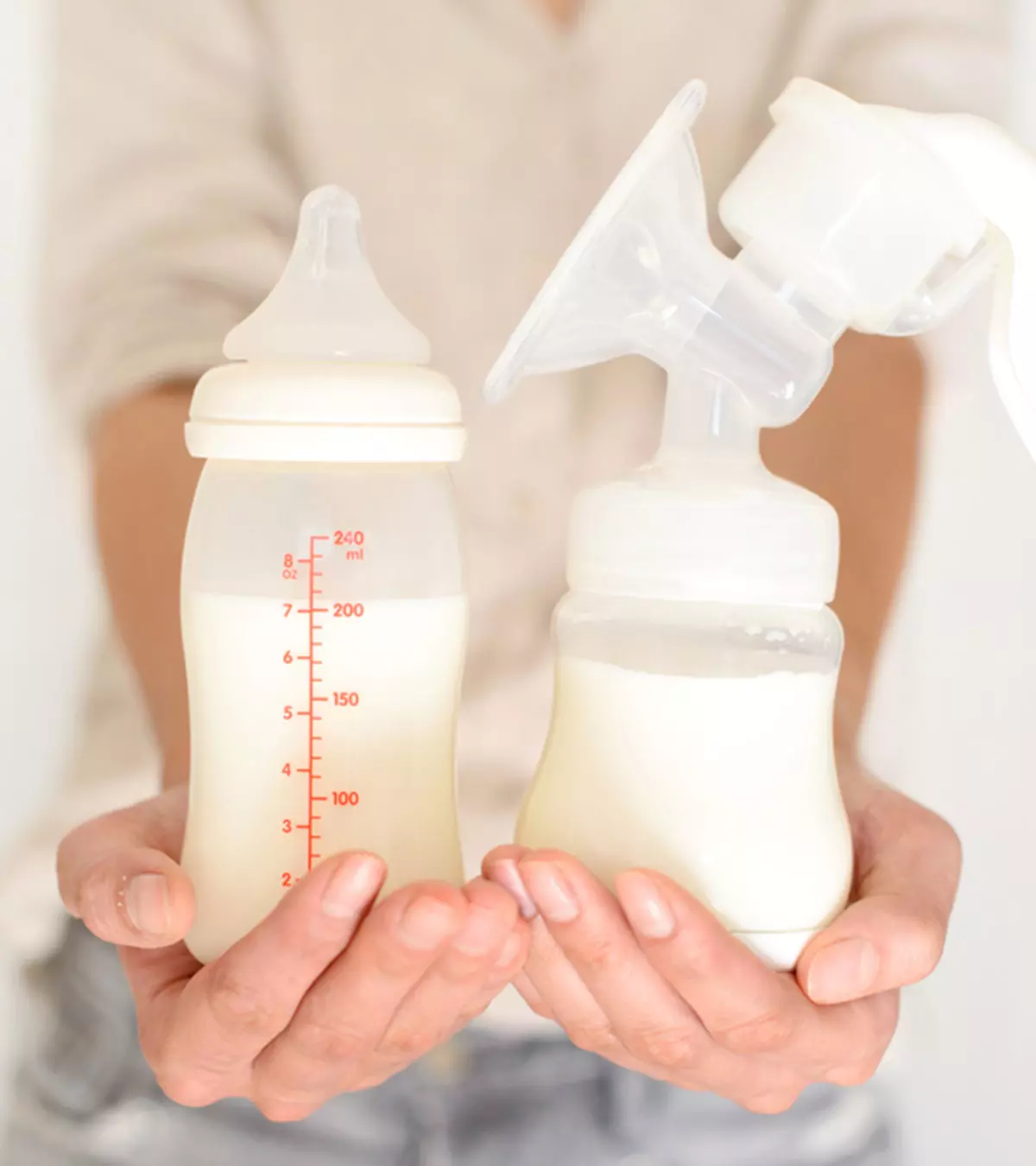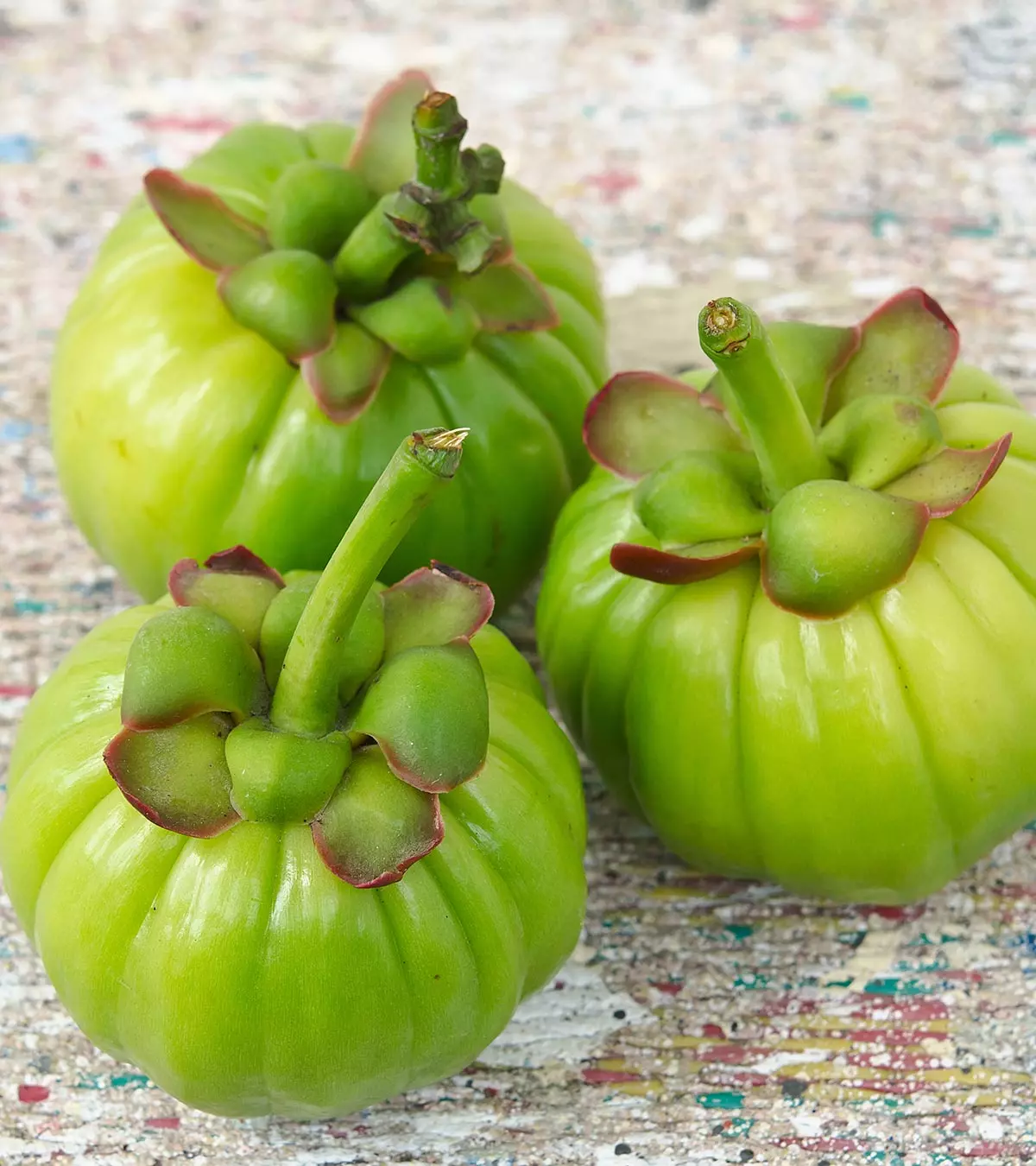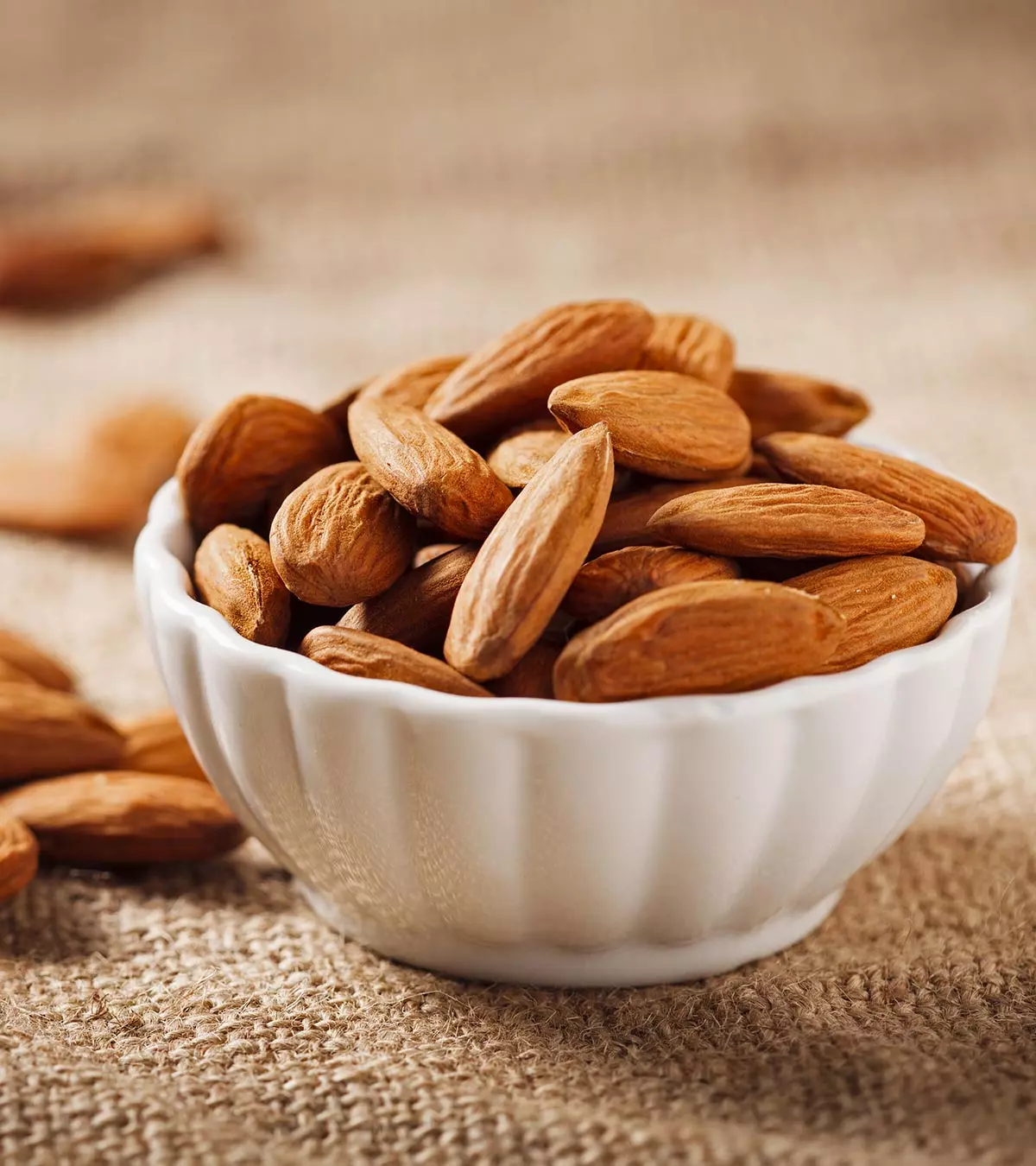
Image: Midjourney/ MomJunction Design Team
Consuming specific foods that increase breast milk can benefit nursing mothers with a low milk supply. Since breast milk is a newborn’s sole source of nourishment, it is important to ensure your body produces adequate amounts of it.

Low milk production is rare but may be caused by certain health conditions and may affect the baby’s weight gain. In such cases, the infant’s nutritional needs are met with supplements such as infant formula. According to the American Academy of Pediatrics (AAP), 19.4% of breastfed infants are given commercial Infant formula supplements in the first 48 hours after birth (1).
However, when nursing moms experience low milk production without specific causes, following a well-balanced diet rich in vitamins and minerals is essential. Additionally, staying hydrated is key to maintaining an adequate milk supply. Read on to learn more about foods that promote milk production.
Key Pointers
- Mothers with low milk production may benefit from consuming lactogenic foods.
- Foods such as fenugreek, dates, oats, apricots, curry leaves, garlic, fennel, and cumin seeds may help boost milk production.
- Consuming anti-lactogenic foods such as sage, peppermint, caffeine, and alcohol may lower breast milk production.
- Other methods to boost breast milk supply include breastfeeding more often, breast massage, and refraining from using pacifiers and nipple shields.
Milk Production After Delivery
Milk or colostrum levels may be low for the first few days due to factors such as C-section, stress, or bleeding after birth. But the amount you produce will still be enough for your baby. The amount of milk may increase around days three through five, depending on your frequency of breastfeeding (2).
The graph shows the values of breast milk production after delivery through days one to eight. Day one and two yield low milk supply, but the level increases from day three (3).

Milk production in the first 8 days postpartum
Source: Boss, Melinda & Gardner, Hazel & Hartmann, Peter. (2018). Normal Human Lactation: closing the gap.Lactogenic Foods That Increase Breast Milk Supply
Kristin Gillespie, MS, RD, LDN, a registered dietitian and a certified nutrition support clinician from Virginia, says, “Several foods are known for their ability to increase milk supply, either due to their nutrient profile or inherent chemical properties that stimulate breast milk production. Among these are leafy green vegetables, whole grains, flaxseed, almonds, pumpkin, fennel, and protein-rich foods.”
These food items in the postpartum diet may improve breast milk supply, enhance milk composition and provide adequate nutrition for nursing mothers. You may speak to a lactation consultant who can help you choose breast milk increasing foods as well as recommend various other measures to improve milk supply.
1. Oatmeal
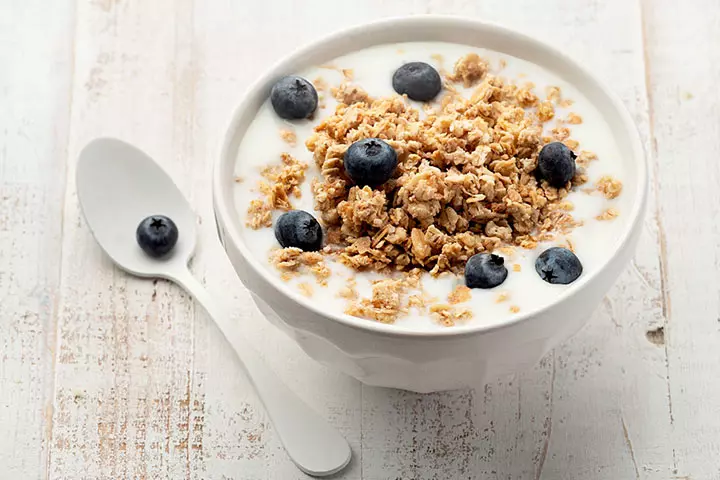
Oats is a whole-grain food with a wide nutritional profile as it contains carbohydrates, fibers, proteins, vitamins, and minerals. It can be a healthy sumptuous meal or breakfast for the nursing mother. Besides, it is counted as one of the foods that increase milk supply by increasing the oxytocin hormone levels (4). You can use oatmeal to prepare various food items, such as cookies, cake, bread, and porridge. However, if you have anemia, diabetes, celiac disease, gluten sensitivity, or intestinal disease, it is best to avoid eating oats (5).
2. Barley
Barley is a nutrient and fiber-rich grain that can enhance your breastfeeding diet’s nutritional value.
Barley is a nutrient and fiber-rich grain that can enhance your breastfeeding diet’s nutritional value. Also, it may promote breast milk supply by increasing serum prolactin levels (6). You can add the least processed hulled barley to recipes, such as soups, stews, curries, and porridge. Using barley flour for preparing barley biscuits, crackers, or pancakes is another way to add barley to your nursing diet. However, nursing women with wheat or gluten allergy, and celiac diseases are recommended to avoid eating barley (7).
3. Apricots

Apricots belong to the almond family and offer several nutrients and health-promoting bioactive compounds. It is also believed to increase prolactin hormone levels to boost breast milk supply (8) (9). You can add fresh or dried apricot to porridge, cereal, and dessert to reap its benefits. But, avoid using canned apricot with syrup as it is high in sugar (8).
4. Carrots
Carrot is a fiber-rich root vegetable that can add color and vital nutrients to your nursing diet. You can eat a raw carrot with peel in salads and sandwiches or cook it with other foods. Regular consumption of carrot will provide nutrients and may also up your breast milk supply. Phytoestrogens present in carrots may be responsible for carrot’s lactogenic effects (10) (11). However, you should eat carrots in moderation as their excess intake might lead to carotenemia. In this condition, your skin may develop an orange hue because of its beta-carotene content (12).
Regarding carotenemia’s prevalence, Melissa Piliang, a dermatologist at the Cleveland Clinic, says, “Carotenemia is pretty uncommon, but we probably see one or two cases a year… One medium carrot has about 4 milligrams of beta-carotene in it. So if you’re eating 10 carrots a day for a few weeks, you could develop it” (12).
5. Fenugreek
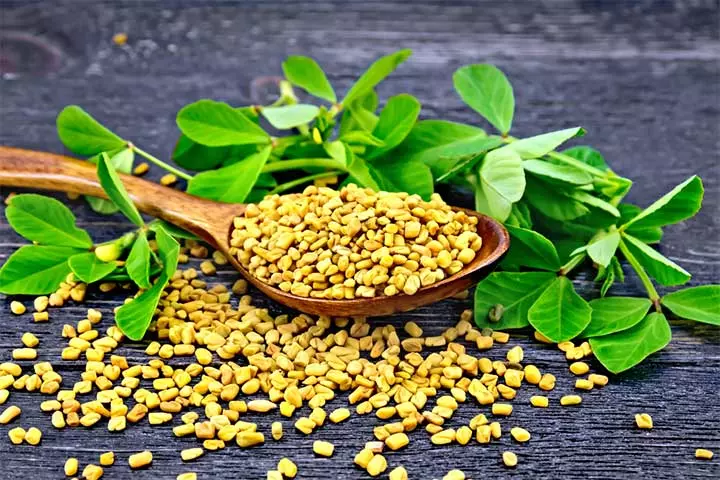
Fenugreek leaves and seeds are popular galactagogues commonly consumed as postpartum food in several cultures (13). The plant may improve milk supply and has several medicinal and nutraceutical properties that could benefit health over time (14). You can add fenugreek to soups, stews, and curries. It is important to note that fenugreek is a potent herb, and can sometimes cause bloating and stomach irritation. It can also interfere with medication, so talk to your doctor before taking any foods with added fenugreek.
 Caution
Caution6. Garlic
Garlic is popular for its therapeutic and medicinal properties (15). In some cultures, garlic is commonly used for its purported galactagogue effects (16). You can add garlic to your diet to add flavor and attain its health benefits. However, it may alter the flavor of breast milk and may trigger colic in babies. Therefore, stay alert to any changes in your baby’s feeding pattern and behavior after you consume garlic.
7. Alfalfa
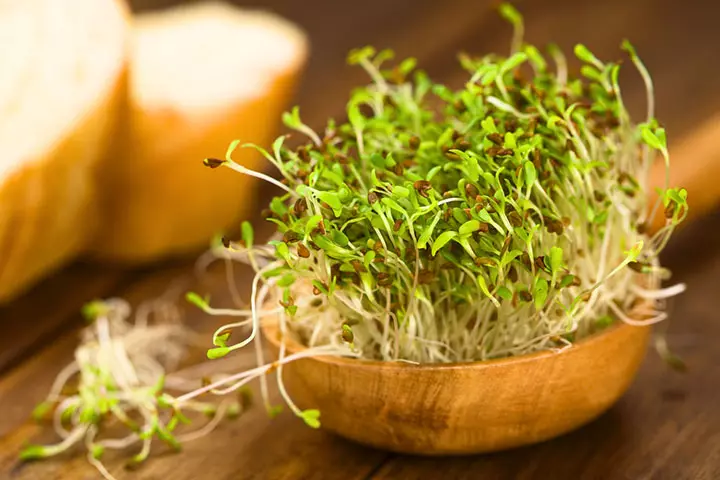
Alfalfa belongs to the legume family and contains estrogenic isoflavonoids (17). Anecdotal evidence suggests that alfalfa may enhance breast milk supply. You can add alfalfa sprouts to salads and soups to make it a part of your breastfeeding diet. Also, you may try alfalfa tea or organic alfalfa as herbal supplements after consulting your healthcare provider. However, for those taking warfarin or those who are suffering from autoimmune diseases like systemic lupus erythematosus, it is best to avoid taking alfalfa (17).
8. Fennel
The consumption of fennel during lactation is prevalent for its purported lactogenic effects (18). The herb contains phytoestrogens that may increase milk supply. Also, research highlights its health benefits, such as enhanced digestion (19). Adding fennel powder to different foods such as soups, stews, curries, and porridge is a great way to use fennel for increasing milk supply. Additionally, you can drink fennel water or fennel tea, which are both refreshing and healthy. However, it should be consumed in moderation, as its excess intake can adversely affect breastfeeding mothers and their infants. Some studies show that the anethole component in fennel has been found to cause toxicity in two breastfed newborns whose mothers were consuming excess herbal tea containing fennel.
Fennel may also cause allergic reactions affecting mothers’ skin, respiratory, and gastrointestinal systems. Nursing moms should avoid consuming fennel if they or their infants are allergic to carrots, celery, or other plants in the Apiaceae family (20).
9. Cumin seed
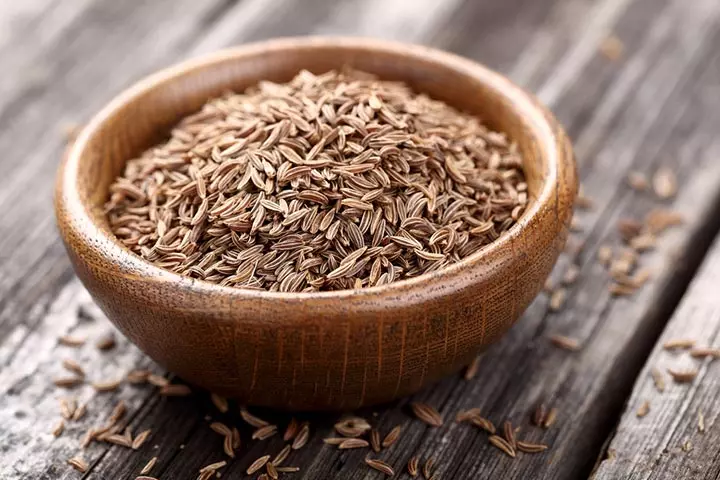
Lactating mothers often consume cumin seeds since it may improve breast milk production (21). You can consume cumin water or use it as a condiment to a variety of preparations. But, it is best to use this herb in small quantities as an ingredient in foods.
10. Green leafy vegetables
Green leafy vegetables are an excellent source of micronutrients, dietary fiber, and bioactive compounds that could improve postpartum recovery and maternal nutrition (22) (23). Besides, they contain phytoestrogens that may enhance breast milk supply. You can add several green leafy vegetables, such as spinach, kale, and collards, to your diet and enjoy their benefits. However, make sure to wash the vegetables thoroughly under running water to avoid any bacterial contamination.
11. Bitter gourd
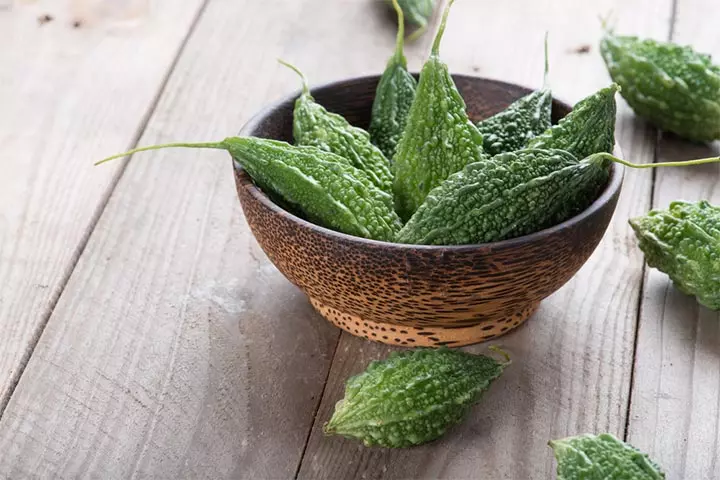
Although bitter, the health benefits and medicinal properties of bitter gourd are unparalleled (24). Anecdotal evidence suggests that bitter gourd may even increase breast milk supply. You can consume bitter gourd curry and baked chips to attain its benefits. However, some studies indicate that the momordicine component in bitter gourd can lower blood glucose (25). Therefore, it is best to limit or avoid eating bitter gourd if you’re already on insulin, as it may enhance the effect of insulin and may lower the blood sugar to extreme levels.
12. Salmon
Salmon is a low-mercury fish rich in high-quality protein, vitaminD, B12, and omega-3 fatty acid nutrients that benefit the mother and the baby (26). Research suggests that regular consumption of salmon may improve breast milk supply and enhance milk composition (27). Wash and cook the salmon properly to reduce the potential risk of exposure to harmful chemicals accumulated by the fish from the polluted water bodies.
13. Moringa
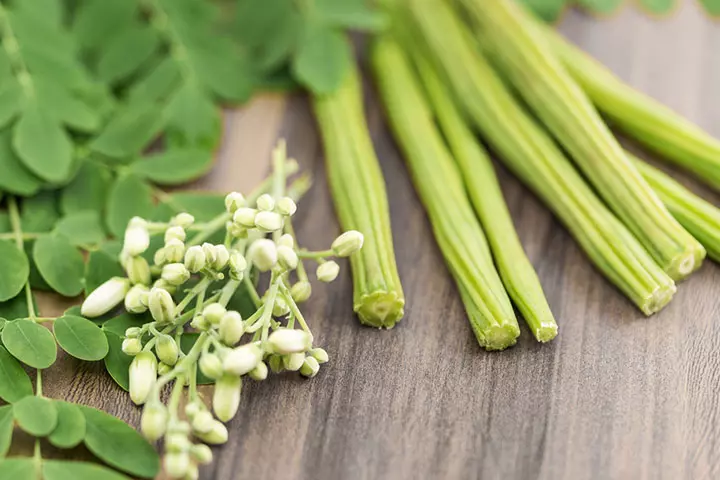
The moringa plant, also known as drumsticks, is widely consumed in parts of Asia and Africa. The leaves and pods of moringa are rich in micronutrients, such as calcium and iron. Nursing mothers need these nutrients for postpartum recovery and health. Besides, drumsticks might increase breast milk supply by stimulating mammary glands (28) (29). You can include drumsticks to your lactation diet by adding its pod or leaves to soups, stews, and curries of your choice. However, if you’re at risk of developing blood clots, avoid the consumption of moringa, as it may stimulate blood clotting (29).
 Research finds
Research finds14. Blessed thistle
Blessed thistle is a plant whose flower, stem, and leaves are used for medicinal purposes. Its use is prevalent in many cultures for its purported galactagogue properties (30). You may consume blessed thistle tea or capsules for increasing breast milk supply after consulting a certified herbalist or a lactation consultant. However, it is essential to know that excess consumption of this herb may lead to allergic reactions and gastrointestinal disturbances, such as stomach cramps, nausea, and vomiting (30).
15. Chickpea
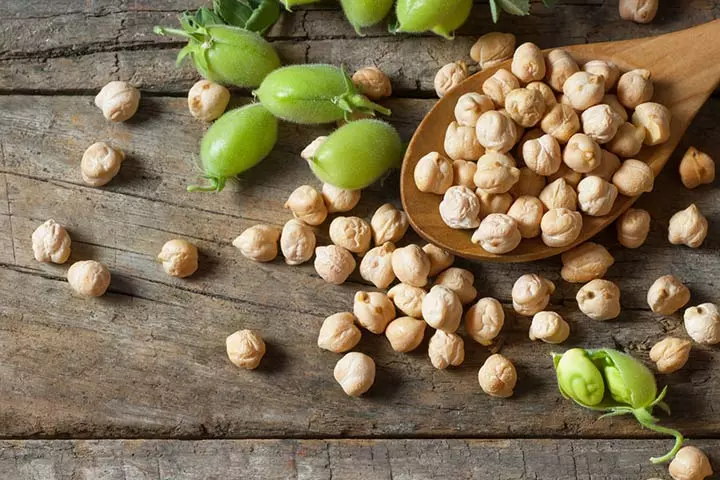
Chickpea is rich in high-quality protein, micronutrients, and bioactive compounds (31). The phytoestrogens present in it are considered to provide lactogenic benefits. You can add chickpea to preparations, such as curries and soups, and dips, such as hummus. However, chickpea is a common allergen and may sometimes cause indigestion. Avoid its consumption if you have a peanut allergy to avert the risk of cross-reactivity.
16. Tofu
Tofu is a soy product rich in protein and essential micronutrients that can enhance maternal health. Anecdotal evidence shows that tofu may improve breast milk supply due to its phytoestrogen content. You can add tofu to a variety of preparations, such as soups, salads, and curries (32). However, eat tofu in moderation, as its excess intake may cause gastrointestinal problems like constipation and diarrhea. Also, do not eat tofu if you have a soy allergy (33).
17. Holy basil

Holy basil is an aromatic medicinal herb that serves several culinary and medicinal purposes (34). The use of holy basil to promote breast milk production is common in some cultures. You can add holy basil in small amounts to your food or consume it as it is with a cup of warm milk. However, avoid consuming basil in excess, especially if you are on some medications. Holy basil can react with blood thinning, sugar, and blood pressure medications, potentially leading to adverse effects (35).
18. Sesame seeds
Sesame seeds are rich in protein, calcium, fiber, and several other vital nutrients. Its phytochemicals, such as quercetin and sesamin, could promote prolactin secretion and improve breast milk supply (36). You can eat a teaspoon of sesame seeds with lukewarm water or add it to recipes, such as salads, bread, pasta, sandwiches, and homemade snacks. However, ensure that sesame seeds are included in moderation, as their excess can lead to weight gain and digestive issues (37).
19. Almonds

Sweet almonds may promote breast milk production due to its potential estrogenic activity (8). You can eat a handful of almonds during midday, add them to food as almond flour or almond butter, or drink almond milk. Almonds offer vital nutrients, such as protein, calcium, and healthy fats. However, if you or anyone from your family has a history of nut allergy, avoid eating almonds (8).
20. Flaxseed
Flaxseed is rich in alpha-linolenic acid (ALA) and other vital micronutrients that the mother and the baby need for growth and development (38)(39). Additionally, flaxseed contains phytoestrogens that may increase your breast milk supply. You can consume flaxseed while breastfeeding in different forms. For instance, you can consume toasted flaxseed with warm water or add flaxseed flour to soups and stews. You can also make salad dressings with flaxseed oil to reap its benefits. Consume flaxseeds with plenty of water, as it may worsen constipation and cause intestinal blockage in rare cases (40).
21. Ginger
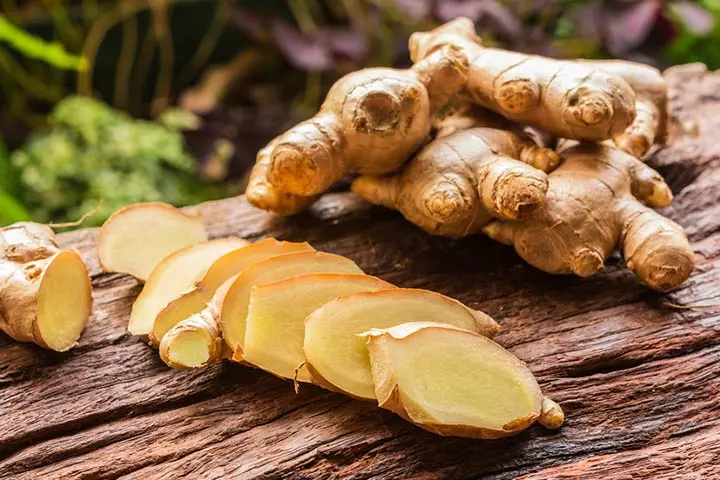
Fresh ginger is widely known for its health and medicinal benefits. It may also increase breast milk production (41). You can add fresh ginger pieces or juice to different foods and beverages. If you wish to consume ginger supplements, consult a lactation consultant or doctor first. Ginger is generally safe for lactating mothers, but mild side effects, such as bad taste and abdominal discomfort, may occasionally occur (42).
22. Brewer’s yeast
Brewer’s yeast, also known as baker’s yeast, is a nutritional supplement rich in vitamins and minerals (43). It is a type of fungus and popularly consumed as a galactagogue in several cultures. You may add brewer’s yeast to your diet after consulting a doctor or lactation consultant, especially if you’re taking medicines for diabetes, are susceptible to yeast infections, or are suffering from Crohn’s disease (43).
 Be watchful
Be watchful23. Pumpkin seeds
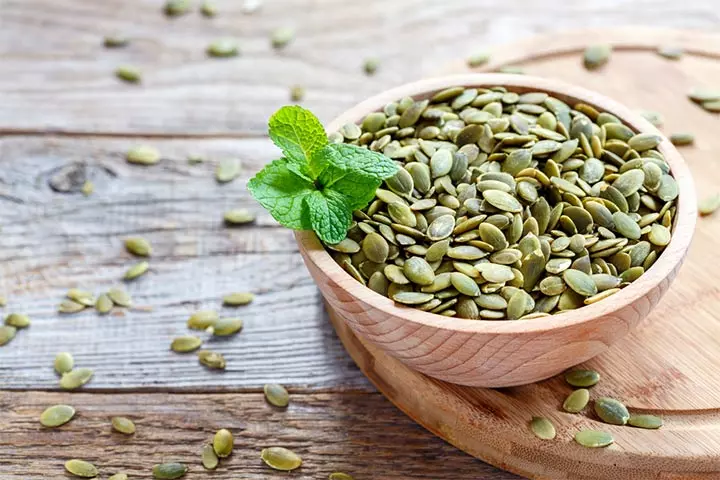
Anecdotal evidence suggests that pumpkin seeds may boost milk production. They are also rich in protein, iron, fiber, and health-promoting bioactive compounds (44). You may consume a teaspoon of pumpkin seeds as a part of the trail mix or chop it and add it to salads, soups, and porridges. Pumpkin seeds powder is another product that you can add to your diet in various ways. However, excessive intake of pumpkin seeds may cause an upset stomach (45).
24. Dill seeds
Dill is a popular herb and also used as a spice. In Ayurveda, dill seeds are used for promoting appetite, aiding digestion, and boosting milk production (46). However, it may cause skin-related allergic reactions, especially if one comes in direct contact with fresh dill (47). You can add whole or crushed dill seeds to soups, stews, curries, and salads. Dill vinegar and dill dressings are other food products you may consider trying.
Sara Namusoga, a mom and blogger, used dill on the recommendation of a dietitian to improve her breast milk production. Sharing her experience, she says, “I had never heard of this herb, but she (dietitian) sounded confident, and so off to the market we went to buy dill. I vividly remember starting the dill diet at 4.00 p.m. and by 9 p.m. I had my own milk river flowing effortlessly (i).”
25. Curry leaves
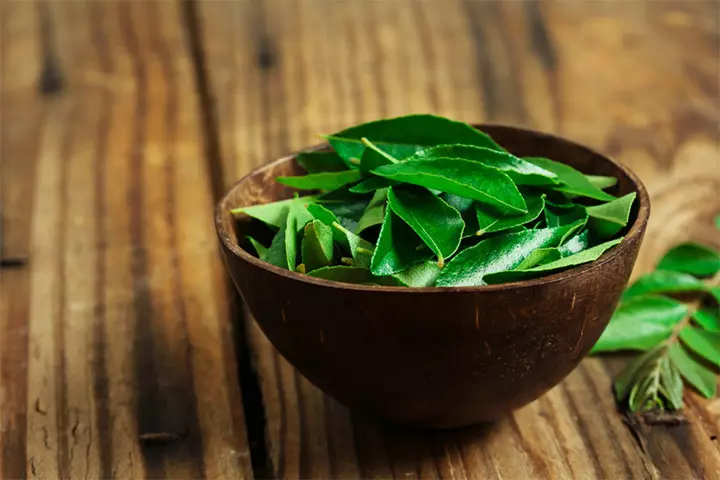
Fresh curry leaves and their powder are often used to add flavor and aroma to food. Besides, their use is common in Ayurveda and other alternative medicines for treating several ailments. Nursing mothers across several cultures use curry leaves to promote their milk supply.
26. Sweet potato leaves
Sweet potato leaves can offer you fiber, micronutrients, and health-promoting phytochemicals. Research shows that sweet potatoes leaves could increase prolactin levels and boost breast milk production (48). Sweet potato leaves or greens can be used to prepare delicious stir-fry and salad recipes. However, sweet potato leaves contain oxalates, compounds that can contribute to the formation of kidney stones in susceptible individuals.
27. Turmeric
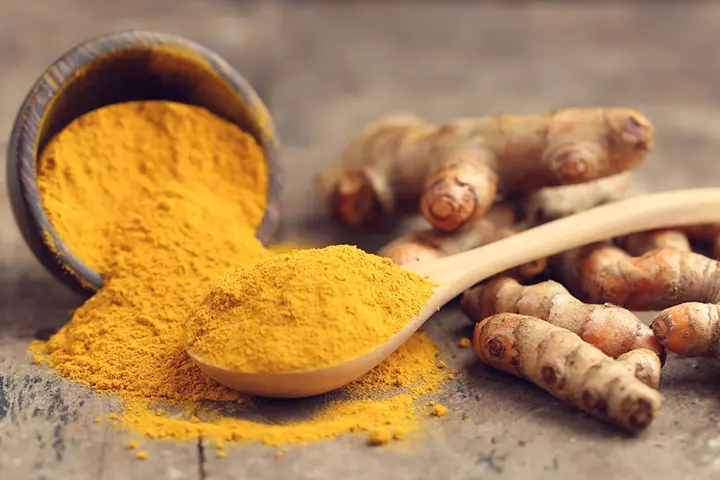
Turmeric is used in culinary and alternative medicines or traditional remedies. Research shows that using turmeric, along with fenugreek and ginger, could increase breast milk volume (49). You can add turmeric as a spice to soups, stews, and curries. However, avoid its excess intake, as it can have side effects and drug interactions, as it can cause side effects and interact with certain medications, such as warfarin (50).
28. Papaya
Papaya is not recommended during pregnancy, but its use during lactation is popular for its potential lactogenic effects. Research shows that papaya and papaya leaf juice could promote breast milk production (51) (52). You can eat papaya fruit as a snack or add it to other food items, such as porridge.
29. Dates

Dates could increase your prolactin hormone levels and enhance breast milk production (8). You can consume a handful of dry or fresh dates as snacks or add it to foods, such as porridge and desserts. Dates can also provide several nutrients and phytochemicals that can enhance your overall health.
30. Poppy seeds
Poppy seeds are obtained from the poppy plant and are a common culinary ingredient in Asian cuisine. Research suggests that poppy seeds can up your breast milk supply on regular consumption (53). You can use poppy seeds to add a nutty flavor and texture to the bread, cookies, curries, confectionery items, pancakes, and waffle batters. However, make sure to buy poppy seeds from a trusted source as contaminated poppy seeds and poppy seed tea may increase the risk of opioid overdose and may lead to misuse and opioid use disorder (54).
31. Brown rice
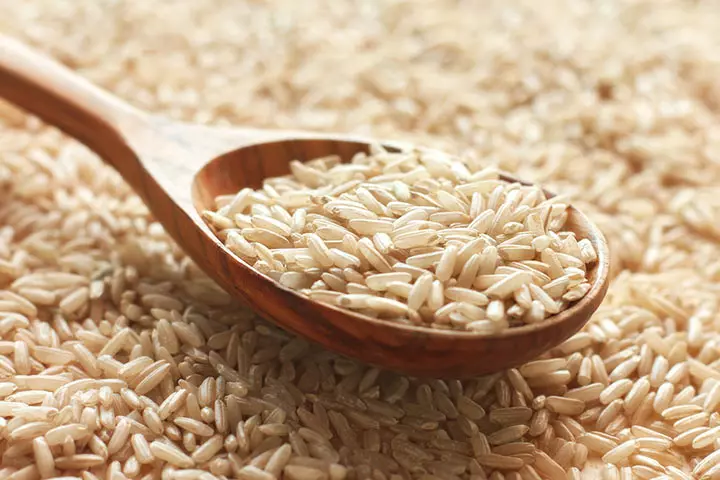
Brown rice is a whole-grain that adds vital nutrients and dietary fiber to your diet. It could help in postpartum weight loss and provides several health benefits. It may also work as a galactagogue and boost milk supply (55). You can enjoy plain brown rice or use it to make sweet and savory recipes. However, make sure to limit its consumption when breastfeeding as it has high levels of arsenic (56).
The effects of these milk-boosting foods are mostly backed by anecdotal evidence, and there are insufficient scientific studies to conclude their effects. It is best to consult a lactation expert and discuss your low milk supply before trying any new food, herb, or supplement to increase milk supply.
Foods That Reduce Breast Milk Supply
If you intend to increase your milk supply, then there are some foods that you may avoid since they are considered antilactogenic, that is, they may reduce breast milk supply. Sage, parsley, peppermint, and chasteberry are some common foods believed to reduce breast milk (57), and the common antilactogenic beverages include alcohol and caffeinated drinks. Consuming them in moderation or avoiding them can help ensure a steady milk supply. Alcohol can lead to decreased milk letdown, while caffeine may cause irritability in infants.
There is no conclusive evidence to prove that these food items are antilactogenic. The effects could vary in each mother, and you may have to proceed based on your observation of the baby’s feeding pattern. If you sense your baby is getting insufficient milk due to your consumption of a food item, stop eating it. If the breast milk supply continues to be low, speak to a lactation consultant.
Why To Use Foods to Increase Breast Milk Supply?
Trying different foods that increase breast milk supply is safer, easier, and has little to no side effects. Moreover, most foods that increase breast milk production also have high nutrient content, which helps provide essential nutrients to the mother while enhancing breast milk quality. Nursing mothers can try medications to increase breast milk production. However, these medicines may have several side effects which outweigh their benefits. Even several herbal supplements that can act as galactagogues do not have enough evidence to support their safety and efficacy for lactating women and their babies (58). Therefore, consuming different galactagogue foods as a part of a well-balanced diet is the safest way to increase breast milk production and supply in breastfeeding women.
Other Measures To Increase Breast Milk Supply
A balanced diet, adequate hydration, a healthy lifestyle, and sufficient sleep could help maintain optimum milk supply during lactation (52). The following are some other practices that may help enhance breast milk supply (59).
- Frequently nurse your baby. Nursing is a demand- and supply-based process. The more you feed your child, the more breast milk you produce.
Doreen Hsu, MScFN, an Ontario, Canada-based registered dietician, says, “Breastfeeding consistently is the best way to increase milk production. Our bodies respond to demand. As our baby nurses more frequently and stays on longer, our milk ducts will be stimulated to increase production. Granted, it can take 12 weeks for breastfeeding to be well established after birth, and being at a good nutritional status is also needed.”
- Express breast milk if your baby isn’t able to empty the breast. Emptying breast gives positive feedback to breasts to produce more milk.
Estelle Link, a mom of two, had feeding problems with her firstborn, which hindered her milk production. Sharing practical tips to improve milk production, she says, “If you are a crazy milk-production-worried-mother like I was, you can try techniques like power pumping, drastically improving the milk flow (several times a day, 30 min pumping, alternating sides every 5 min). I did it for my first child, and it worked because he was doing a poor job by himself, and it needed to be compensated by breast pumping to keep a good milk production (ii).”
- Take a nursing vacation and spend some days nursing your baby exclusively for two to three days.
 Quick fact
Quick fact- Feed the baby from both breasts. Switch sides two to three times during a feeding session. But before you switch sides, let the baby finish feeding from one breast. This way, your baby can get the hindmilk.
- Avoid using nipple shields and pacifiers as they may interfere with the feeding process by creating nipple confusion.
- Avoid the introduction of solids before your baby is six months old or developmentally ready. Continue to breastfeed as long as you and your baby desire.
- Keep a check on medication that could interfere with milk production. Contraceptives and decongestants, such as pseudoephedrine, may decrease breast milk supply.
- Rest well, and stay calm. A stress-free routine with proper sleep is necessary to avoid fatigue.
- Use an appropriate nursing bra as wearing a tight bra may compress the breast and affect milk flow. Prolonged obstruction of milk flow could increase the risk of clogged ducts and infection.
- Massage your breasts to ease clogging of the ducts and improve blood circulation. It may help increase breast milk supply and milk flow.
Frequently Asked Questions
1. What is the recommended daily intake of fenugreek to increase breast milk production?
The recommended daily intake of fenugreek to increase breast milk production is 3.5-6 grams. However, consult your doctor or lactation consultant first and stick to the quantity recommended by them (60).
2. Does drinking water play a role in increasing breast milk supply?
Sufficient hydration is crucial for producing breast milk. The volume of fluid intake impacts milk production (61). Therefore, inadequate hydration, especially when consistent, may affect your breast milk supply.
3. Can a mother’s diet affect the taste of her breast milk?
According to research, it is suggested that flavors of the maternal diet might affect the taste of breastmilk. Common food items that might cause this change include garlic, carrot, mint, anise, caraway, and eucalyptus (62).
4. Are there any specific vitamins or minerals that are particularly important for breastfeeding mothers to consume?
According to the CDC, it is important for mothers to consume essential vitamins such as vitamin B12, K, D and minerals such as iodine, choline, iron as they are beneficial to the infant’s health (63).
5. Are all foods labeled as lactogenic effective in increasing milk supply?
Not all foods labeled as lactogenic are effective in increasing milk supply. There is limited scientific evidence that suggests certain foods increase milk supply, and most evidence is anecdotal.
Low milk supply can be bothersome for nursing mothers since it could affect the baby’s health. In most cases, adequate hydration, proper sleep, and a well-balanced diet can help replenish the supply. You may consider trying some foods that increase breast milk production and supply, such as leafy vegetables, fruits, nuts, and seeds, which are commonly believed to increase milk supply. If you do not notice any improvement, consult a doctor or lactation consultant.
Infographic: Common Galactagogue Vegetables And Spices
As a new mother, if you’re worried that your breast milk supply will not be enough for your baby, several lactogenic foods that might help. The infographic below includes everyday vegetables and spices that can increase the breast milk supply. Check them out!
Some thing wrong with infographic shortcode. please verify shortcode syntax
Illustration: Best Foods To Increase Breast Milk Supply

Image: Dall·E/MomJunction Design Team
Personal Experience: Source
MomJunction articles include first-hand experiences to provide you with better insights through real-life narratives. Here are the sources of personal accounts referenced in this article.
i. Breastfeeding: My experience- theory vs. practice;https://medium.com/connecting-cities/breastfeeding-my-experience-theory-vs-practice-c48392584164ii. Breastfeeding — All the techniques and tricks I had to learn, and more;
https://medium.com/@estelle.link.el/breastfeeding-all-the-techniques-and-tricks-i-had-to-learn-and-more-ad6d01af974b
References
- Joan Younger Meek et al.; Policy Statement: Breastfeeding and the Use of Human Milk; American Academy of Pediatrics
https://publications.aap.org/pediatrics/article/150/1/e2022057988/188347/Policy-Statement-Breastfeeding-and-the-Use-of - Breastfeeding and Delayed Milk Production;
https://www.hopkinsmedicine.org/health/conditions-and-diseases/breastfeeding-and-delayed-milk-production - Boss Melinda & Gardner Hazel & Hartmann Peter; Normal Human Lactation: closing the gap; ResearchGate
https://www.researchgate.net/figure/Daily-values-for-milk-production-in-the-first-8-days-postpartum-Figure-shows-weighted_fig1_325879847 - Foods that promote lactation; Jamaica Hospital Medical Center
https://jamaicahospital.org/newsletter/foods-that-promote-lactation/ - Coeliac disease and gluten sensitivity
https://www.betterhealth.vic.gov.au/health/conditionsandtreatments/coeliac-disease-and-gluten-sensitivity - Barley; Drug and Lactation Database; NCBI
https://www.ncbi.nlm.nih.gov/books/NBK501827/ - Gluten-free diet; Mayo Clinic
https://www.mayoclinic.org/healthy-lifestyle/nutrition-and-healthy-eating/in-depth/gluten-free-diet/art-20048530 - Top 10 superfoods for breastfeeding moms; Sanford Health
https://news.sanfordhealth.org/womens/top-10-breastfeeding-superfoods/ - Tabasum Fatima et al.; Nutritional and health benefits of apricots; International Journal of Unani and Integrative Medicine
https://www.researchgate.net/publication/328274247_Nutritional_and_health_benefits_of_apricots - Krishan Datt Sharma et al.; Chemical composition functional properties and processing of carrot—a review; NCBI
https://www.ncbi.nlm.nih.gov/pmc/articles/PMC3550877/ - Desmawati Desmawati and Delmi Sulastri; Phytoestrogens and Their Health Effect
https://www.ncbi.nlm.nih.gov/pmc/articles/PMC6390141/ - Can Eating Too Many Carrots Turn Your Skin Orange? Cleveland Clinic
https://health.clevelandclinic.org/can-eating-too-many-carrots-turn-your-skin-orange - Fenugreek; Drug and Lactation Database; NCBI
https://www.ncbi.nlm.nih.gov/books/NBK501779/ - Sajad Ahmad Wani and Pradyuman Kumar; Fenugreek: A review on its nutraceutical properties and utilization in various food products; Science Direct
https://www.sciencedirect.com/science/article/pii/S1658077X15301065 - Leyla Bayan et al.; Garlic: a review of potential therapeutic effects; NCBI
https://www.ncbi.nlm.nih.gov/pmc/articles/PMC4103721/ - Garlic; Drug and Lactation Database; NCBI
https://www.ncbi.nlm.nih.gov/books/NBK501782/ - Alfalfa; Dug and Lactation Database; NCBI
https://www.ncbi.nlm.nih.gov/sites/books/NBK501830/ - Fennel; Drug and Lactation Database; NCBI
https://www.ncbi.nlm.nih.gov/books/NBK501793/ - Gurmeet Singh Sarla; Saunf: Do we really need fennel seeds after a meal?; Researchgate
https://www.researchgate.net/publication/335840673_Saunf_Do_we_really_need_fennel_seeds_after_a_meal#:~:text=Sugar%20coated%20and%20uncoated%20fennel - Fennel; Drug and Lactation Database; NCBI
https://pubmed.ncbi.nlm.nih.gov/30000852/ - Cumin; Drug and Lactation Database; NCBI
https://www.ncbi.nlm.nih.gov/books/NBK501873/ - Vegetable of the month: Leafy greens; Harvard Health
https://www.health.harvard.edu/heart-health/vegetable-of-the-month-leafy-greens - Lucia Bacciottini et al.; Phytoestrogens: food or drug?; NCBI
https://www.ncbi.nlm.nih.gov/pmc/articles/PMC2781234/ - Mamta Thakur and R. K. Sharma; Bitter Gourd: Health Properties And Value Addition At Farm Scale; Researchgate
https://www.researchgate.net/publication/312580416_BITTER_GOURD_HEALTH_PROPERTIES_AND_VALUE_ADDITION_AT_FARM_SCALE_a - N. Mini Raj et al.; 15 – Bitter gourd: Momordica spp.; ScienceDirect
https://www.sciencedirect.com/science/article/abs/pii/B9780080408262500199 - Top Commercial Seafood Items; Seafood Health Facts
https://www.seafoodhealthfacts.org/?s=salmon - Nini H Sissener; Are we what we eat? Changes to the feed fatty acid composition of farmed salmon and its effects through the food chain; Journal of Experimental Biology
https://pubmed.ncbi.nlm.nih.gov/29514891/ - Vaishnavi Satheesh; Lactation A Connection to Baby; ACTA Scientific Nutritional Health
https://actascientific.com/ASNH/pdf/ASNH-03-0424.pdf - Moringa; Drug and Lactation Database; NCBI
https://www.ncbi.nlm.nih.gov/books/NBK501899/ - Blessed Thistle; Drug and Lactation Database; NCBI
https://www.ncbi.nlm.nih.gov/books/NBK501775/ - Rinkesh Kumar Gupta et al.; Health Risks and Benefits of Chickpea (Cicerarietinum) Consumption; NCBI
https://pubmed.ncbi.nlm.nih.gov/27779388/ - Ganokwun Buntuchai et al.; Traditional Galactagogue Foods and Their Connection to Human Milk Volume in Thai Breastfeeding Mothers; NCBI
https://pubmed.ncbi.nlm.nih.gov/28609178/ - Soy; NCCIH
https://www.nccih.nih.gov/health/soy - Maimes Report on Holy Basil; Researchgate
https://www.researchgate.net/publication/230634694_Maimes_Report_on_Holy_Basil - 5 Health Benefits of Basil; Cleveland Clinic
https://health.clevelandclinic.org/benefits-of-basil - S J Al-Bazii et al.; Histological Effects of SesamumIndicum Seeds on Mammary Gland tissue in Female white Rats; Researchgate
https://www.researchgate.net/publication/335066146_Histological_Effects_of_Sesamum_Indicum_Seeds_on_Mammary_Gland_tissue_in_Female_white_Rats/fulltext/5d4d6aed92851cd046aeb983/Histological-Effects-of-Sesamum-Indicum-Seeds-on-Mammary-Gland-tissue-in-Female-white-Rats.pdf - Panpan Wei et al.; Sesame (Sesamum indicum L.): A Comprehensive Review of Nutritional Value Phytochemical Composition Health Benefits Development of Food and Industrial Applications; NCBI
https://pmc.ncbi.nlm.nih.gov/articles/PMC9573514/ - Seed of the month: Flaxseeds; Harvard Health
https://www.health.harvard.edu/heart-health/seed-of-the-month-flaxseeds - Omega-3 Fatty Acids; National Institute Of Health
https://ods.od.nih.gov/factsheets/Omega3FattyAcids-Consumer/ - Flaxseed and Flaxseed Oil; NCCIH
https://www.nccih.nih.gov/health/flaxseed-and-flaxseed-oil - Panwara Paritakul et al.; The Effect of Ginger on Breast Milk Volume in the Early Postpartum Period: A Randomized Double-Blind Controlled Trial; Researchgate
https://www.researchgate.net/publication/306020631_The_Effect_of_Ginger_on_Breast_Milk_Volume_in_the_Early_Postpartum_Period_A_Randomized_Double-Blind_Controlled_Trial - Ginger; Drug and Lactation Database; NCBI
https://www.ncbi.nlm.nih.gov/books/NBK501786/ - Brewer’s yeast; Mount Sinai
https://www.mountsinai.org/health-library/supplement/brewers-yeast - Mukesh Yadav et al.; Medicinal and biological potential of pumpkin: an updated review; Cambridge University Press
https://www.cambridge.org/core/journals/nutrition-research-reviews/article/medicinal-and-biological-potential-of-pumpkin-an-updated-review/614835C9F2CABAAAFD5E7925A72E7F9F - Pumpkin; University of Michigan Health
https://www.uofmhealth.org/health-library/hn-2151005/amp/ - Jana and G. S. Shekhawat; Anethum graveolens: An Indian traditional medicinal herb and spice; NCBI
https://www.ncbi.nlm.nih.gov/pmc/articles/PMC3249919/#:~:text=Anethum%20graveolens%20L. - Dill; Drug and Lactation Database; NCBI
https://www.ncbi.nlm.nih.gov/books/NBK501877/ - Ima Candra Kusuma et al.; Sweet potato (ipmoea batatas l.) leaf: its effect on prolactin and production of breast milk in postpartum mothers; Belitung Nursing Journal
https://www.belitungraya.org/BRP/index.php/bnj/article/view/72 - Akkarach Bumrungpert et al.; Effects of Fenugreek Ginger and Turmeric Supplementation on Human Milk Volume and Nutrient Content in Breastfeeding Mothers: A Randomized Double-Blind Controlled Trial; Researchgate
https://www.researchgate.net/publication/328847566_Effects_of_Fenugreek_Ginger_and_Turmeric_Supplementation_on_Human_Milk_Volume_and_Nutrient_Content_in_Breastfeeding_Mothers_A_Randomized_Double-Blind_Controlled_Trial - Turmeric; Drug and Lactation Database; NCBI
https://www.ncbi.nlm.nih.gov/books/NBK501846/ - Marthia Ikhlasiah et al.; The effects of papaya leaf juice for breastfeeding and working mothers on increasing prolactin hormone levels and infant’s weight in Tangerang; Researchgate
https://www.researchgate.net/publication/343169313_The_effects_of_papaya_leaf_juice_for_breastfeeding_and_working_mothers_on_increasing_prolactin_hormone_levels_and_infant’s_weight_in_Tangerang - Desti Nataria and Sherly Oktiarini; Increased Production Of Breast Milk With The Papaya Fruit Consumption; JurnalKesehatan
https://ejurnal.stikesprimanusantara.ac.id/index.php/JKPN/article/view/340 - Asie Shojaii and Fataneh Hashem Dabaghian; Management of Breastfeeding Problems in Iranian Traditional Medicine; NCBI
https://www.ncbi.nlm.nih.gov/pmc/articles/PMC4499079/ - Poppy seed tea: Beneficial or dangerous? Mayo Clinic
https://www.mayoclinic.org/diseases-conditions/drug-addiction/expert-answers/poppy-seed-tea/faq-20559907 - All about Breastfeeding for Mothers; Medwin Publishers
https://medwinpublishers.com/NHIJ/NHIJ16000117.pdf - Brown Rice or White Rice: Which Is Your Healthier Option?; Cleveland Clinic
https://health.clevelandclinic.org/brown-rice-or-white-rice-which-is-your-healthier-option - 5 best and worst foods for breast milk supply; Le Bonheur Children’s Hospital
https://www.lebonheur.org/blogs/practical-parenting/5-best-and-worst-foods-for-breast-milk-supply - Treasure M McGuire; Drugs affecting milk supply during lactation; NCBI
https://www.ncbi.nlm.nih.gov/pmc/articles/PMC5828930/ - Educating Breastfeeding Mothers on How to Boost Milk Supply; University Hospitals
https://www.uhhospitals.org/services/obgyn-womens-health/patient-resources/pregnancy-resources/Breastfeeding-Guide/breastfeeding-tips-to-increase-your-milk-supply - Boosting Your Breast Milk Supply With Galactagogues; American Pregnancy Association
https://americanpregnancy.org/healthy-pregnancy/breastfeeding/galactagogues-boosting-your-milk-supply/ - 4 factors that can decrease breast milk supply – and how to replenish it; UT Southwestern Medical Centerr
https://utswmed.org/medblog/decrease-breast-milk-supply/ - Joanne M Spahn et al.; Influence of maternal diet on flavor transfer to amniotic fluid and breast milk and children’s responses: a systematic review; PubMed.
https://pubmed.ncbi.nlm.nih.gov/30982867/ - Breastfeeding: Diet Vitamins and Minerals
https://www.cdc.gov/breastfeeding-special-circumstances/hcp/diet-micronutrients/?CDC_AAref_Val=https://www.cdc.gov/breastfeeding-special-circumstances/hcp/diet-micronutrients/?CDC_AAref_Val=https://www.cdc.gov/breastfeeding/breastfeeding-special-circumstances/diet-and-micronutrients/index.html - How can I use fenugreek to increase my breast milk supply? Southwestern Medical Center
https://utswmed.org/medblog/fenugreek-breast-milk-supply/ - Siraphat Fungtammasan et al.; The effect of Moringa oleifera capsule in increasing breastmilk volume in early postpartum patients: A double-blind randomized controlled trial; PLoS One
https://www.ncbi.nlm.nih.gov/pmc/articles/PMC8023461/ - Brewer’s Yeast; Drugs and Lactation Database; NIH
https://www.ncbi.nlm.nih.gov/books/NBK572248/
Community Experiences
Join the conversation and become a part of our nurturing community! Share your stories, experiences, and insights to connect with fellow parents.
Read full bio of Rebecca Koyf
- Kristin is a registered dietitian and certified nutrition support clinician (from West Virginia University) based in Virginia Beach, VA, with ten years of experience. She is practicing as a nutrition manager for Option Care Health, Illinois, after earning a Master’s degree in human nutrition from Eastern Michigan university.
 Kristin is a registered dietitian and certified nutrition support clinician (from West Virginia University) based in Virginia Beach, VA, with ten years of experience. She is practicing as a nutrition manager for Option Care Health, Illinois, after earning a Master’s degree in human nutrition from Eastern Michigan university.
Kristin is a registered dietitian and certified nutrition support clinician (from West Virginia University) based in Virginia Beach, VA, with ten years of experience. She is practicing as a nutrition manager for Option Care Health, Illinois, after earning a Master’s degree in human nutrition from Eastern Michigan university. - Doreen Hsu has 13 years of hospital experience in child and family nutrition and maternity and postpartum nutrition in hospitals in Toronto, Ontario. She holds a masters degree in Food and Nutrition from the University of Western Ontario.
 Doreen Hsu has 13 years of hospital experience in child and family nutrition and maternity and postpartum nutrition in hospitals in Toronto, Ontario. She holds a masters degree in Food and Nutrition from the University of Western Ontario.
Doreen Hsu has 13 years of hospital experience in child and family nutrition and maternity and postpartum nutrition in hospitals in Toronto, Ontario. She holds a masters degree in Food and Nutrition from the University of Western Ontario.
Read full bio of Swati Patwal
Read full bio of Rohit Garoo
Read full bio of Shinta Liz Sunny






